Modern Methods of Water Proofing
Special Issue - eMagazine
The old traditional systems of water proofing are being replaced by modern water proofing systems due their inherent limitations. Modern methods of water proofing aim to understand the functional behaviour of the structure, understand the properties of the available materials arrive at a system, which is best suited for the structure and incorporate the system at the design stage only. A single product or technique is not usually enough, involvement of various bodies and techniques in coordination is essential for making structures waterproof.
For success of any system the building structure should have sufficient and efficient control joints if the slabs dimensions are more than twenty meter in any direction. Control joints are structural engineering design features. These joints are supposed to be designed and their configuration marked on the drawings and their detailing needs to be given with respect to waterproofing system proposed in large buildings. Different types of control joints are Construction joints or day joint, crack inducer joint, contraction joint and expansion joint. If proper control joints are not provided in large slabs, no waterproofing system works.
Structure should be designed to resist the ingress of water into the concrete and for durability such as:
- The exclusion of moisture migration within the construction
- Low permeability achieved by introducing silica fume into concrete
- Low porosity is maintained by low water/cement ratio for waterproof concrete should have maximum value of 0.4
- Low water absorptivity and penetration be maintained by introducing special admixtures/additives called hydrophobic pore blockers.
1.0. Modern Methods
Modern technique relies basically on two main water proofing systems, which are fool proof and simple.
Flexible membrane method
- Liquid applied membrane
- Preformed elastomeric membrane
- Special Coatings
Crystalline waterproofing method
Integral Water Proofing Method
1.1. Liquid Applied Coating
Liquid-applied membranes are applied on site in a liquid form which is allowed to set and form into a water impermeable membrane. Bituminous-based (except those containing coal tar) and polymeric-based membranes can be applied when they are cold while those containing coal tar are usually applied when heated.
Acrylic, bituminous, cementitious, coal tar, epoxy, silicone, urethane, polyurethane, polyuria materials are used as film forming membrane over concrete surface. These materials are applied either hot or cold over concrete by using brush, broom, roller, squeeze, spray etc.
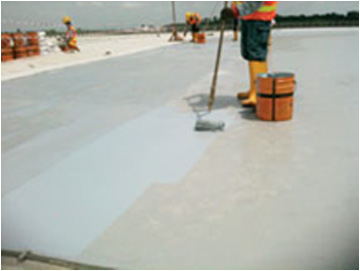
Application of liquid-applied membrane using Roller.
Liquid-applied membranes are seamless, semi-flexible, and easy to apply, detail, maintain and repair. However careful supervision and control during application is needed, particularly in ensuring proper curing of concrete, consistent thickness and uniform application. The polyuria material is used as a liquid applied coating to a concrete surface which gives better results than the polyurethane material. The polyuria membrane is used in low movement structure, waste water treatment plants and substructures. Whereas, the polyurethane material is used in high movement structures, car parking, roofs etc.
Application methods are discussed in the subsequent sections. Table 1 below gives comparison of properties of different coatings.
Table 1 - Comparison of properties of different coatings
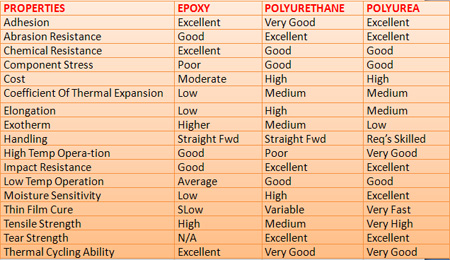
Source: ReBuild-Issue-Jan/March 2011-Published by Dr.Fixit Institute
1.2. Pre-formed Elastomeric Membrane
The bituminous Butyl rubber, EPDM (Ethylene Polypropylene Diene Monomer), Hypalon, Neoprene, Polyethylene, HDPE, PVC (Poly Vinyl Chloride), materials are used as pre-formed elastomeric membrane applied by torch on, self adhesive, loose lay technique. Some of the methods are already discussed under conventional methods.
One type of pre-formed membranes is the polymer-modified bitumen membranes and they are applied by heat or attached with an adhesive. These blended or ‘modified’ asphaltic products are bonded to a high strength fabric of polyester or fiberglass and produced into rolls. They have elongation and recovery properties which make them suitable to protect against stresses created by wind, temperature fluctuation and normal structural expansion and contraction of the building. Some of these products are also modified to increase their resistance to fire, thus increasing their fire-rating.
Styrene-butadiene-styrene (SBS) rolls are modified with 'rubbers' and compatible with petroleum products. Atactic Polypropylene Polymer (APP) rolls are modified with 'plasticizers' and not compatible with all petroleum-based products, grease and oils.
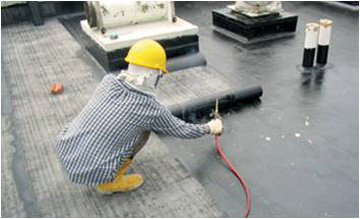
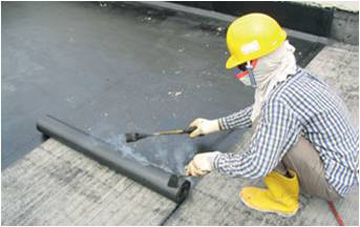
Softening polymer-modified bitumen membrane by heat welding
Another type of pre-formed membrane is made of Polyvinyl Chloride (PVC). Although PVC is a hard resin, it is modified with the addition of plasticizers to make it more supple and pliable for use as roofing membranes. PVC membranes are mainly produced by either the calendering or extrusion process. In the calendering process, a reinforcement layer of glass fiber or polyester scrim is normally incorporated into the membrane to provide greater strength and dimensional stability. Like all thermoplastic membranes, they turn soft when subjected to heat. Some proprietary membranes are formulated with heat reflective compounds capable of lowering the surface temperature of the roof membrane by as much as 15%.
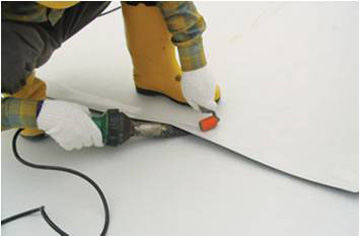
Using hot air torch to weld the joint of PVC membranes
Selection Parameters
When selecting a membrane it is essential to consider a number of relevant factors including:
- Whether the membrane will be exposed to weather or protected subsequently.
- Type of floor finishes and adhesives overlaid subsequently
- Environmental conditions
- Anticipated structural movement of the substrata
- Expected service life of the membrane
- Maintenance requirements
- Availability of authorized applicators
- Setting time of coats
- The moisture content of the substrate
- Cost implication
- Ease of application
1.3. Special Coatings
Silicone Water Repellents
- Solvent/Water Based System.
- Does not allow fungus patch or biological growth on the surface.
- Protects Costly Exteriors for long period.
Applications Areas: External Facades, Stone Facades
Cementitious Coating
- Cementitious Waterproofing Compound.
- It penetrates the capillary & Seals them.
Applications Areas: Water Tanks, Bathroom Slabs, Lift Pits, Masonry Walls, Sloping Roofs etc.
Elastomeric Membrane
- Two Component Flexible Waterproofing coating.
- Elastomeric WP Membrane with 200% Elasticity to take care of movements.
- UV Resistant with Excellent Waterproofing characteristics.
- Impermeable under positive & Negative Loads
Applications Areas: Swimming Pools, Roof, Terrace Gardens, Fountains, Underground & Overhead Tanks, Extended Roofs, Water Bodies
Liquid Applied Waterproofing Membrane
- Two Component Flexible Waterproofing coating.
- Elastomeric WP Membrane with 400% Elasticity.
- UV Resistant with Excellent Waterproofing characteristics
- Available in different colors.
Applications Areas: Sloping Roofs, Dome shaped Structures, External Facades
Acrylic Polymer Modified Waterproofing Coating
- Acrylic Co-polymer based Waterproofing System.
- Two Component Heavy Duty Systems.
- Breathable Coating, allows Concrete to breathe.
Applications Areas: Terrace Slabs, Basements, Sloping Roofs, Water Retaining Structures
Latex Polymer coatings
- Improved tensile & flexural Strength.
- Excellent Adhesive to Concrete.
- High Resistance to water penetration.
- Reduction in W/C, increases Durability & Toughness.
- Repairing mortars for old & spalled structures.
Applications Area: Sunken Areas Can be used in repairing of honey combed structures.
Roof coatings have proved to be a useful tool in maintaining and sustaining roof systems. Current elastomeric coatings not only can protect underlying roof membranes but also can provide energy savings through solar reflectivity.
While making a choice involving coatings as primary water proofing system, adhesion plays a key role. It acts as an interface between the substrata and the applied system itself. Dirt or any other foreign material will act as a deterrent and the system becomes ineffective. Adhesion of a coating to a roof substrate improves as the coating dries or cures (chemically reacts with moisture from the air). Depending on a coating’s chemistry, its cure time, dry time and skin time may be different. Some coatings, such as urethanes and silicones, not only must dry but also cure to achieve complete property development. Factors such as substrate temperature, air temperature and relative humidity will affect drying time and ultimate cure.
Some advanced techniques like Polyurea coatings etc are described in subsequent sections with reference to leading manufacturers specifications.
Building Envelope
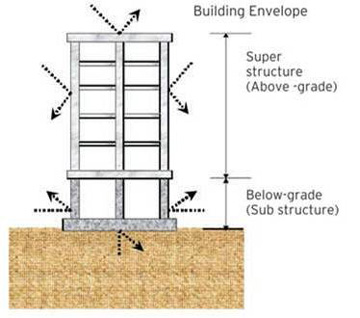
Source: ReBuild-Issue-Jan/March 2011-Published by Dr.Fixit Institute
In this scheme of water proofing system, the entire building is enveloped using different and suitable water proofing methods to act integrally. Figure below schematically represents the Building Envelope system. The system commences at foundation level above the blinding concrete or PCC and gets terminated at the general ground level in the first phase. In the second phase, the entire super structure is treated suitable admixtures to enhance properties of concrete, masonry, plaster and other façade. In the last phase, the roof water proofing is introduced including appropriate treatment of parapet walls and other vertical surfaces. In this system of water proofing, even the construction joints, different stages of structural elements are treated using appropriate water stoppers, injection grouts etc.
2.0. Integral Water Proofing
The basic approach found to be useful in the application of construction chemicals is to cast as good a concrete as possible so that the concrete itself is watertight. It should be rendered watertight by making it denser and rectifying the various defects like honeycombs, capillaries, cracks etc. are corrected in the body of the concrete itself. This makes the concrete strong and dense and a stronger concrete is more likely to be watertight over a longer period of time than a weak concrete that is covered with some barrier.
3.0. Crystalline Method
Crystalline Technology
Crystalline Technology waterproofs and improves the durability of concrete structures by filling and plugging the pores, capillaries and micro-cracks with a non-soluble, highly resistant crystalline formation. The waterproofing effect is based on two simple reactions, one chemical and one physical. Concrete is chemical in nature. When a cement particle hydrates, the reaction between water and the cement causes the concrete to become a hard, solid mass. The reaction also generates chemical by-products such as calcium hydroxide, sulfates and carbonates of sodium potassium and calcium as well as un-hydrated or partially hydrated cement particles all of which reside in the capillary tracts of the concrete.
Crystalline waterproofing introduces another set of chemicals to the concrete. When these two chemical groups, the by-products of cement hydration and the crystalline chemicals, are brought together in the presence of moisture, a chemical reaction occurs. The end product of this reaction is a non-soluble crystalline formation.
This crystalline formation can only occur where moisture is present, thus it will only form in the pores, capillary tracts, and shrinkage cracks of the concrete. Wherever water goes, crystalline waterproofing will form filling the pores, voids and cracks.
When the crystalline waterproofing chemicals spread into and through the concrete they become available to the by-products of cement hydration thus allowing the chemical reaction to take place forming a non-soluble crystalline structure. As the chemicals continue to diffuse through the water, the crystalline growth will form behind the advancing chemical front. The reaction will continue until the crystalline chemicals are either depleted or run out of water. Chemical diffusion can carry these chemicals up to 12 inches into the concrete. If water has permeated two inches into the substrate, then the crystalline chemicals can only diffuse to this depth but, they still have the potential to penetrate 10 inches further.
Instead of reducing the porosity of concrete, like water reducers and super plasticizers, the crystalline formation fills and plugs the voids in concrete becoming an integral and permanent part of the structure.
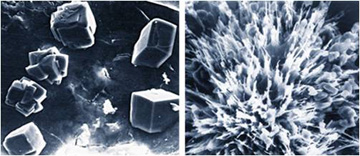
Left: Scanning electron microscope (SEM) view of a concrete pore; Image courtesy of Xypex
Right: SEM view of a concrete pore filled with crystalline formation; Image courtesy of Xypex
Because these crystalline formations are within the concrete and are not exposed at the surface, they cannot be punctured or otherwise damaged like membranes or surface coatings. Crystalline waterproofing is highly resistant to chemicals where the pH range is between three and 11 under constant contact, and two to 12 under periodic contact. Crystalline waterproofing will tolerate temperatures between -25 degrees Fahrenheit (-32 degrees Centigrade) and 265 degrees Fahrenheit (130 degrees Centigrade) in a constant state. Humidity, ultraviolet light, and oxygen levels have no impact on the products ability to perform.
Crystalline waterproofing offers protection against the following agents and phenomena:
- Inhibits the effects of CO, CO2, the gasses responsible for the corrosive phenomenon known as ‘carbonation’ a process in which exterior gasses create a corrosive phenomenon that softens the surface layers of the concrete. Carbonation testing shows that the crystalline formation in the capillary tracts reduces the flow of gases into concrete, thus significantly retarding carbonation.
- Protects concrete against alkali aggregate reactions (AAR) by denying water to those processes affecting reactive aggregates.
- Chloride ion diffusion testing shows that crystalline waterproofing reduces the diffusion of chlorides in concrete structures. This helps protect reinforcing steel and prevents deterioration that could occur from oxidation and expansion of steel reinforcement.
Michael Brown, P.E., principal with Golder Associates in Seattle, has used crystalline waterproofing in numerous applications, but notably on the Blackbird mine remediation project near Salmon, Idaho, which has very low pH acidic mine water flowing through concrete structures. "We use crystalline waterproofing technology as an additive to concrete to reduce permeability and provide protection for the epoxy coated reinforcing bar," said Brown.
More traditional methods of protecting concrete still leave it open to chemical and water damage. Membranes and other coatings are susceptible to errors caused by faulty workmanship such as pinholes, improperly sealed seams, blistering, delamination and damage during backfilling. Unlike crystalline waterproofing, they also deteriorate over time and lose their effectiveness.
Application
Crystalline waterproofing and protection technology is available in powder form. There are three different application methods:
- Applied as a coating to the surface of an existing concrete structure, for example, a foundation wall or a floor slab.
- Mixed directly into the concrete at the batch plant as an admixture.
- Shaken as a dry powder onto fresh concrete and trowelled into the surface.
Methods and Procedures of Crystalline Waterproofing Coating Applications
Crystalline waterproofing can be applied by brush or with spray equipment. To ensure the success of the application, care must go into the conditions under which the material is applied, i.e. surface preparation, surface wetting, coat thickness, and curing time.
Because the crystalline waterproofing coating system has a unique chemical diffusing characteristic, proper surface preparation of the concrete is critical to the performance of the material. Concrete surfaces that will receive the crystalline waterproofing coating need to have an open pore texture to allow the transfer of the reactive crystalline chemicals from the coating into the concrete substrate. The surface also needs to be clean and free of dirt, form oil, and other foreign matter as this can potentially cause de-lamination of the coating.
The three common methods of concrete surface preparation are water blasting, sand blasting and acid etching. When water blasting, the pressure should be 3,000 pounds per square inch (psi) to 4,000 psi. Sand blasting is normally required when steel forms have been used and the concrete has a tight, mirror like finish. Acid etching can be accomplished using either muriatic acid or citrus-based products when the use of an acid is not environmentally acceptable.
Wetting the Surface
The coating systems require that the concrete be in a saturated, surface damp condition for the waterproofing to be effective. The active chemicals in the coating use water as a migrating or diffusing medium that allows the chemicals to transfer from the coating into the capillary tracts of the concrete. To make sure that concrete on vertical surfaces is saturated, wet the walls with clean water and allow the moisture to be drawn into the substrate for approximately ten minutes. Re-wet the walls a second time and allow standing for 20 minutes.
In hot weather, when evaporation rates are high, it may be necessary to soak the concrete overnight. This can be accomplished using soaker hoses at the top of walls that allow water to flow down the vertical surfaces, or a series of sprinklers if walls are less than 12 to 15 feet.
If water is not readily available on the job site, the saturation of the concrete should be done early in the morning when evaporation rates are low and before the concrete begins to heat up. In difficult conditions with hot sun and wind it is better to attempt small areas that can be controlled rather than large areas at one time. In hot weather the use of an evaporation retarder to help keep moisture in the concrete can be considered.
In cold weather, saturation of the concrete should only take place when the ambient temperature is going to be above 33 degrees Fahrenheit for 24 hours.
Coating Application
The crystalline waterproofing coating materials are mixed with water at a ratio of five parts powder to two parts water by volume for brush application, and five parts powder to three parts water by volume for spray application.
Coatings can be applied by brush, hopper gun or specialized spray equipment. When using a standard six inch masonry brush, one person can mix and apply approximately 80 to100 square feet per hour. A hopper gun or texture gun requires a two-person crew with one mixing the material and the other doing the spraying. The gun uses a 3/8 inch nozzle and operates at roughly 25 psi. A two-person crew can apply the coating at a rate of 400 to500 square feet per hour per coat.
Specialized spray equipment is operated with a three-person crew. At application rates of 1,200 to 1,500 square feet per hour per coat it is necessary to have all materials pre-measured in order to keep up with the spray equipment capacity. When using this type of equipment, the best procedure is to pre-measure the powder into at least five or six large buckets (five gallon pails) and pre-measure the water. This is done on the basis of five parts powder to three parts water by volume.
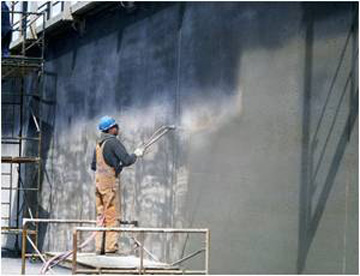
Sprayed on surface application; Photo courtesy of Xypex
On vertical surfaces, the standard application procedure is to start at the top of the wall and work down. When using spray equipment, the first coat should be “back-brushed” using a 20 inch wide janitors broom with a soft bristle or a finisher’s broom. This helps ensure an even coverage rate and minimizes any run down of the coating.
When a second coat is specified, it needs to be applied no later than 48 hours after the first coat. Under normal conditions, the crystalline waterproofing coating will begin to set up in two to three hours and application of the second coat should be done at this point. If the first coat has dried out, it must be lightly sprayed with water prior to the application of the second coat. Failure to do so may result in lack of bond between the two coats.
When applying the coating materials to a large concrete structure, it is better to break the job up into manageable segments rather than try to complete large areas at one time. This is especially important when the weather is hot or windy.
Curing
Moist curing of the crystalline waterproofing system is essential for proper performance and is extremely important for two reasons:
First, crystalline waterproofing uses water as a diffusing medium which allows the reactive chemicals to transfer from the coating into the saturated concrete substrate. If adequate curing of the crystalline waterproofing does not take place, evaporation will first dry out the coating and then begin to pull moisture from out of the concrete. As the concrete substrate dries, further chemical transfer into the substrate will be compromised thus limiting the effectiveness of the application
Second, the crystalline waterproofing coating uses sand and cement as a carrying agent for the active chemicals so curing is necessary for proper hardening of the coating and adhesion to the concrete surface. Curing of the treatment is achieved either by spraying with water or through the use of a specialized evaporation retardant.
Curing the crystalline waterproofing coating should begin as soon as it has hardened sufficiently so as not to be damaged by a fine spray. Under normal conditions, the treatment will be ready for moist curing two to three hours after application. This is accomplished by misting with a fog spray of clean water at least three times a day for two to three days to prevent premature drying.
In warm climates or on hot windy days, increased curing will be required to keep the coating from drying out. This can be achieved by misting the coating five or six times per day for two to three days. Curing should be carried out if 70 percent of the coating is dry and 30 percent is still damp. In this case, the next fog spray should be done.
During the curing period, treated surfaces must be protected from damage by rain, frost, and freezing temperatures. If plastic sheeting is used for protection, it must be raised off the waterproofing coating to allow sufficient air circulation. The overall process of crystalline formation may take two to three weeks to reach full maturity.
Dry-Shake Application
Crystalline waterproofing can also be applied by the dry-shake application method, like floor hardeners to new slabs while under construction. This process requires the crystalline powder compound to be sprinkled onto the surface of slabs with the use of a mechanical spreader after concrete is placed, consolidated, and leveled. The powder is then worked into the surface of the slab during the normal finishing process with a power trowel. Crystalline waterproofing is also available combined with synthetic floor hardeners to both waterproof and harden floor slabs. Typical applications for the dry-shake application are basement slabs and warehouse floors.
Negative Side Waterproofing
Existing basements that are subject to water seepage through foundation walls and floors can be treated by the application of crystalline waterproofing on the negative side, or inside, of the structure. Coatings that depend on their adhesion to the surface will blister and peel when moisture seeping through the concrete dissolves soluble minerals and deposits them on the surface, under the coating, in the form of efflorescence, a white powdery substance that forms on the concrete surfaces. Because crystalline waterproofing penetrates into the concrete, plugging the pores beneath the surface, it does not depend on surface adhesion and will therefore not blister and peel off, like surface coatings. "I specify crystalline waterproofing on virtually every one of my projects as an admixture for the retaining side of walls where applied membranes cannot be used," says Mel Cole, FCSI, an architectural specifier in Soquel, California.
Vapor transmission through basement floors and walls is a common problem that may lead to damp, musty odors. Testing has shown that the application of crystalline waterproofing under these conditions can reduce vapor flows as much as 50 percent, which in most cases, will result in a drier environment.
Other Applications
The material produced in dry powder from crystalline waterproofing products reduces shrinkage and cracking to a wide range of other concrete elements. Crystalline technology can improve the performance of bagged mortar mixes, stuccos, and concrete. The performance of precast concrete panels, as well as precast elements, such as pipes, box culverts, and manholes can also be enhanced.
Conclusion
Although concrete may appear to be a simple product to put together, it requires a highly engineered approach. In an increasingly competitive design and construction environment, where high performance requirements, such as longer life cycles, more durable concrete, and value engineering are expected, careful consideration must be paid to basic requirements, such as the concrete, water, and cement ratio; cementing materials, and more sophisticated chemical admixtures.
Effective use of crystalline waterproofing technology will reduce the porosity and permeability of conventional concrete, and provide the high performance advantages and benefits that building owners and design professionals have come to rely upon in design and construction projects.
Acknowledgement:
The above article is based on the inputs obtained from www.continuingeducation.construction.com and literature of M/s Xypex.